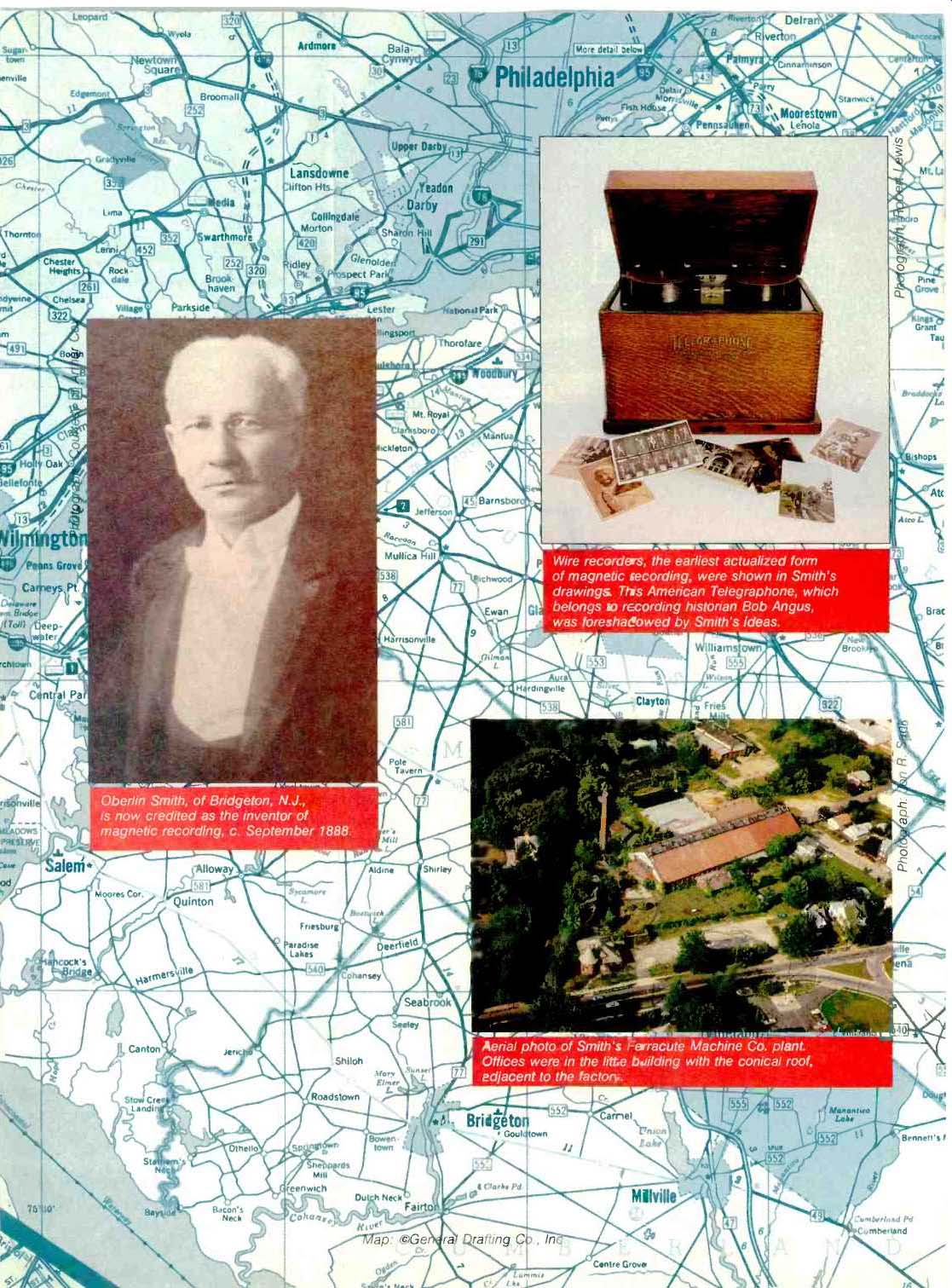
by JON R. SANK
Audio history was revised by a paper in the March 1988 Journal of the Audio Engineering Society. Until then, Valdemar Poulsen of Denmark was thought to have in vented magnetic recording in 1898, with his Telegraphone machine. In the Journal article, "1888-1988: A Hundred Years of Magnetic Sound Re cording," author Friedrich Karl Engel, of the German firm BASF, revealed an 1888 paper by Oberlin Smith of Bridgeton, N.J., proving that Smith had c spawned the idea before Paulsen. It is remarkable that Smith's article remained unknown all these years, de spite the fact that it is readily available on microfilm-even at the Philadelphia Free Library near my home. Fortunately, Engel found Oberlin Smith's writings in time for magnetic recording's centennial year.
When I told this story to one of the junior audiophiles in my family, he found it hard to believe that the art was so ancient. This is understandable be cause magnetic recording was not introduced in the U.S. until after World War II. My AES colleague and audio-museum curator, Jack Mullin, discovered the Magnetophon tape recorder in Germany after the war and brought it to the U.S. He recorded Bing Crosby's radio shows on that machine, using the German tapes. Via a complex chain of events, Ampex and 3M became involved in magnetic recording and developed the recorders and tapes that led to the products of today.
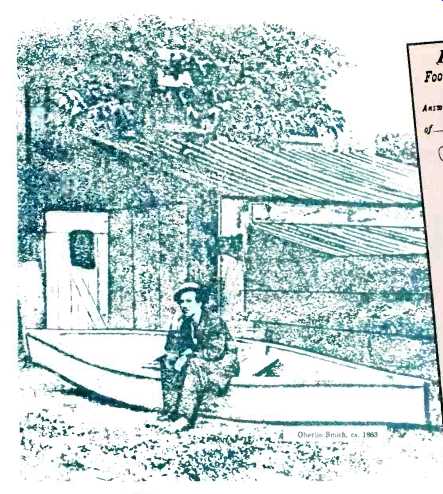
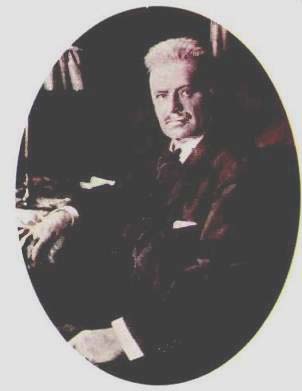
Oberlin Smith (top) and Valdemar Poulsen (above) can each be said to have discovered magnetic recording: Smith has priority, but Poulsen made the first working models.
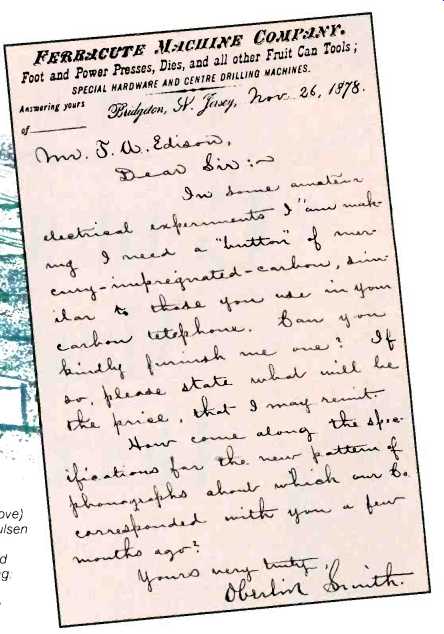
Fig. 1--Oberlin Smith's letter to Thomas Edison. Photo of Smith and this
letter are reprinted from The Antique Phonograph Monthly, February 1975.
The first magnetic recorder I can recall was a Webcor wire recorder; it reproduced speech reasonably well, but music sounded bad. My present antique collection includes an RCA wire recorder which, instead of having open spools like those on the Webcor, has a cartridge resembling an over grown 8-track. In about 1950, I purchased a TapeMaster tape recorder which had only one motor. This recorder never ran at the correct speed, but early on the morning of June 2, 1953, I managed to record the coronation of Queen Elizabeth II via shortwave. I still have the recording, now dubbed to modern tape. (One reel of the master had been on paper-backed tape.) Later, in my acoustic lab at RCA, I had a monstrous RCA RT-11 full-track, 1/4-inch tape recorder which I hardly used because the capstan motor sounded like a railroad car. Finally, some 20 years ago, I obtained the solid-state successor to the RT-11, the RT-21. It is a 2-track, 1/4-inch machine with three big motors and has performed reliably to the present. It is very useful for editing and dubbing to cassettes.
Poulsen's wire recorder was demonstrated at the Paris Exposition of 1900. The lack of amplification prevented it from being a commercial success. Since it was a purely electrical system, amplification was needed. The very popular mechanical cylinder and disc recorders of the early part of the century could drive a reproducing horn directly, and so they did not need amplification.
Nevertheless, Poulsen is reported to have received the Exposition's Grand Prize. His machine seems to have been the first working magnetic recorder. Later versions included magnetic disc and cylinder units. There is no evidence that Smith ever completed a working recorder, and his models perished in a factory fire in 1903.
Oberlin Smith visited Thomas Edison and heard a demonstration of his cylinder phonograph, apparently in 1878. Afterwards, Smith developed ideas on alternate forms of the mechanical phonograph and invented the magnetic recording and playback systems. He documented these ideas by filing papers with the Clerk of Cumberland County, N.J. on September 24, 1878.
Then, on October 4 of that year, he filed a "caveat" paper with the U.S. Patent Office. His experiments at the time were witnessed, but no description of the hardware is available. Shortly after filing the caveat, he wrote a letter to Edison (Fig. 1), requesting some electrical parts. This letter, discovered in the Edison Museum, indicates Smith's developmental activities in the fall of 1878. He was, however, also busy managing a growing tool company, and didn't find time to do any more experiments in the following years. Ten years later, in 1888, he decided to make public his invention by means of a short article, "Some Possible Forms of Phonograph." The article was published in The Electrical World, and in it, Smith encouraged others to continue his work.
I compared the documents of 1878 with the 1888 article and concluded that the systems described are identical. In 10 years, Smith had not made any discoveries which would cause any changes in his invention. His 1911 letter to the Journal of the Franklin Institute (which we'll discuss later) indicated that he did no more work on magnetic recording after 1878, and the models destroyed in the fire were those from his early work. (Both sets of papers also show some proposed variations in Edison's cylinder phono graph.) Two of Smith's sketches from the September 8, 1888 issue of The Electrical World are reproduced here (Figs. 2 and 3). This newspaper-style periodical, though printed in New York and regionally oriented, was widely read by those interested in electricity.
Shortly before the turn of the century, there were many individual inventors working in all areas of electricity. Examining the 1888 issue of The Electrical World showed that one person had built an electric generating plant in his home, while others were inventing telephone gadgets. More search may reveal some long-forgotten device that needs re-inventing.
Figure 2 shows Smith's recorder. A magnetic wire or string travels from one spool to the other. The direct cur rent flowing through the telephone transmitter (carbon microphone) is modulated by the audio signal, and both act to magnetize the moving medium by means of the induction coil.
The d.c. bias in a carbon microphone is relatively stronger than the signal current. This could have functioned similarly to the a.c. bias of modern analog recording, which moves the magnetic operating point to the linear region of the medium.
Figure 3 shows the magnetic recorder in playback mode. A voltage is induced in the pickup coil as the lines of flux from the magnetized media cut the turns of the coil. This audio signal would be heard in the telephone receiver if an amplifier were inserted at point X. Smith recognized that the voltage would be too low to drive the ear phone directly, and therefore he perceived that an "intensifier" was need ed. His only thought was a battery; the vacuum tube amplifier was not invented until the next century.
In the September 29, 1888 issue of The Electrical World, a one-paragraph note quotes a letter from Smith de scribing improvements to recording and playback systems. With reference to our Fig. 2, he wrote that the recording transducer should be a coil wrapped around an electromagnet, with the core against the magnetic medium. This is clearly a forerunner of the magnetic head. The playback pickup helix in Fig. 3 would be shortened to one turn to "localize the magnetism," which fits in with Smith's correct notion of tiny magnets along the string. This modification leads to the modern idea of a very small gap in the playback head core. The playing or reading de vice in any system which scans a moving medium must be small compared to the details in that particular medium, be it magnetic tape, phonograph re cord, digital Compact Disc, or optical film soundtrack.
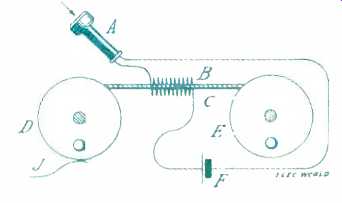
Fig. 2--Smith's magnetic recorder in record mode. Reproduced from the
September 8, 1888 issue of The Electrical World.
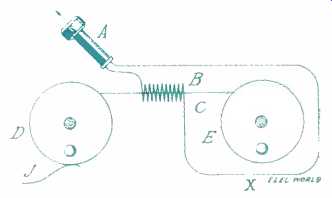
Fig. 3--Smith's magnetic recorder in playback mode. Reproduced from the
September 8, 1888 issue of The Electrical World.
Smith also had some accurate and prophetic thoughts about the recording medium. He thought that it was incorrect to use a magnetic wire, because the little recorded magnets would demagnetize each other, resulting in low output. Therefore, his favored medium was a string or, more specifically, a cotton sewing thread filled with magnetic particles. This was, in principle, the same as our modern plastic tape, which is coated with magnetic powder and held together with some "glue," the binder. Now we know that a magnetic wire will give ample output compared to tape, but the high-frequency response of magnetic wire is poorer if both are running at the same speed. Oliver Read has stated that recording wire must be run at 24 ips to equal the quality of tape at 7 1/2 ips. (See "Suggested Reading" at the end of this article.)
The solid wire proved to be good enough for the telephone quality standards of the day. Poulsen was successful, and Smith was surprised. In Smith's 1911 letter to the Journal of the Franklin Institute, he stated that Poulsen's machines were designed exactly the same as in his own earlier descriptions, but he gave Poulsen credit for discovering that the little recorded magnets in a solid medium do not de magnetize each other. Smith mentioned solid wire as a medium in his 1878 papers filed with the Cumberland County Clerk and in the 1888 article, but he "accidentally" omitted mention of wire in his filing with the U.S. Patent Office. If only Smith could have known that some 40 years in the future, magnetic wire would give way to particle-coated tape.
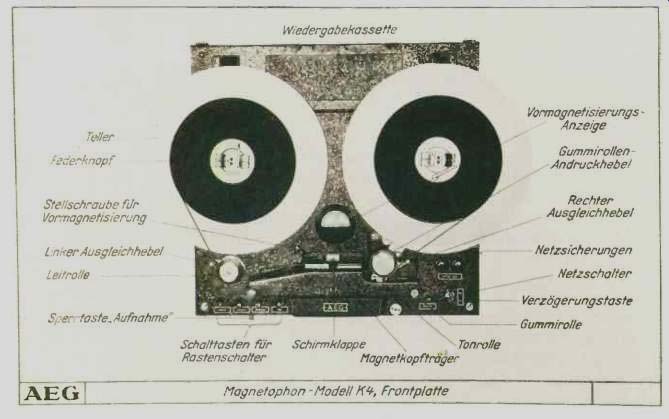
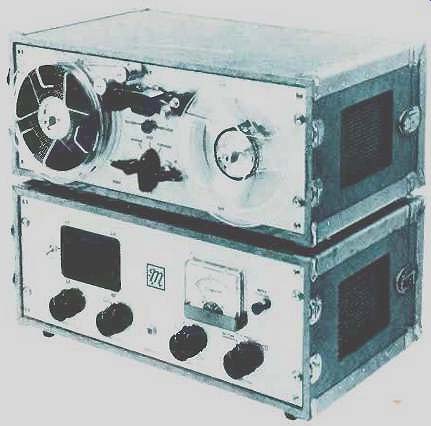
The first recorders (top) to use a ribbon-like tape medium were produced as a joint venture by AEG and BASF in Germany in the early 1930s. Recorders such as the Magnecord PT-6 (above) appeared in the U.S. in the late 1940s.
Who was Oberlin Smith? This interested me, because I have spent much time in Bridgeton, N.J. in recent years, helping the hospital with its paging systems and with noise control of mechanical equipment. I have enjoyed the town's abundance of Victorian architecture and its many historic places.
I contacted William Chestnut of the Bridgeton Antiquarian League, who put me in touch with Arthur Cox, a high school art teacher who is an expert on Oberlin Smith, one of Bridgeton's most famous citizens. Cox had just completed a book titled Ferracute: The History of an American Enterprise, which chronicles Smith's company as well as his spare-time inventions. These included not only magnetic recording but also his Autofono, the first jukebox.
I am indebted to Cox for his book as well as for copies of many old documents which he has collected.
Smith was born in Ohio in 1840 and died in Bridgeton in 1926. He was a prolific inventor and held 70 patents. In 1890, he was president of the American Society of Mechanical Engineers.
Smith never seemed to be short of cash and, at age 23, opened a ma chine shop in Bridgeton which later became the Ferracute Machine Company. Ferracute (which means "sharp iron") made presses for cutting and forming metals, and it grew rapidly because of the need for tools to make tin cans quickly for the food industry. In the early part of the 20th century, the Ford Motor Company became Ferracute's largest customer, and during both World Wars, the plant produced presses for making small-arms ammunition. After World War II, business slowed, and in 1968, the company was sold to the Fulton Iron Works of St. Louis. The Bridgeton plant was closed and remains empty to this day.
One of my hobbies is taking aerial photographs while piloting, and Ferracute's location on a lake made a nice picture (see first page of article). The plant, as shown, was built in 1905, after the 1903 fire destroyed the original, along with Smith's recorders. The Smith mansion, Lochwold, was located on the lake a few hundred yards from the plant. It was destroyed by fire in 1934, and I could see no traces. The plant offices were in the little building with the conical roof, adjacent to the factory building. Smith's office was in the room below the cone.
His most valuable contributions were in the mechanical realm, and his 1896 book, Pressworking of Metals, remains a classic in its field. Oberlin Smith loved to play phonograph records, and, incidentally, he was a very good dancer.
-----------
Author's Acknowledgments
Arthur Cox, in addition to furnishing documents, supplied the formal portrait of Smith at the beginning of this article, for which I am grateful. I would also like to acknowledge the assistance of Allen Koenigsberg, publisher of The Antique Phonograph Monthly, who provided a copy of Smith's letter to Edison, which originally came from the archives of the Edison National Historic Site in West Orange, N.J.
Suggested Reading
Benson, K. B., ed., Audio Engineering Handbook, McGraw-Hill, New York, 1988. Benson's Handbook has a good history of magnetic recording by Busby of Ampex; you may also wish to read my chapter on microphones.
Cox and Malim, Ferracute: The History of an American Enterprise, Bridgeton, N.J., 1985. (Available for $32 postpaid from Arthur Cox, P.O. Box 411, Bridgeton, N.J. 08302.) Read, Oliver, The Recording and Re production of Sound, Howard W. Sams, Indianapolis, 1952. Read's old book contains an excellent description of wire recorders and how they magnetize the wire, as well as a comparison to tape recording.
The Antique Phonograph Monthly, 502 East 17th St., Brooklyn, N.Y. 11226.
Allen Koenigsberg's digest-sized publication is for those avidly interested in the older means of recording, not necessarily collectors. Articles on unusual subjects and the classified advertising section are both interesting.
(adapted from Audio magazine, Dec. 1988)
Also see: The March of Technology: Analog Tape Home Recording (May 1997)
Celebration of Audio's Earliest Years
Hi-Fi Sound on Hi-Fi VCRs (Sept 1988)
Enduring Instruments--Treasures from The Yale Collection (Feb. 1989)
= = = =